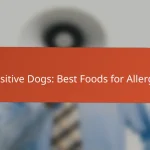What are the best feeding practices for dogs?
The best feeding practices for dogs include providing a balanced diet tailored to their specific needs, which can be achieved through high-quality commercial dog food, home-cooked meals, or raw diet options. Each method has its advantages and considerations that pet owners should evaluate based on their dog’s health, lifestyle, and preferences.
High-quality commercial dog food
High-quality commercial dog food is formulated to meet the nutritional needs of dogs and often adheres to standards set by organizations like the Association of American Feed Control Officials (AAFCO). Look for products that list meat as the first ingredient and avoid those with excessive fillers or artificial additives.
When selecting commercial dog food, consider your dog’s age, size, and activity level. For example, puppies require food rich in protein and calories, while senior dogs may benefit from lower-calorie options to maintain a healthy weight. Always transition between foods gradually to avoid digestive upset.
Home-cooked meals
Home-cooked meals can provide a personalized diet for your dog, allowing you to control ingredients and avoid allergens. However, it’s crucial to ensure that these meals are nutritionally balanced. Consulting with a veterinarian or a pet nutritionist can help you create a suitable meal plan.
When preparing home-cooked meals, include a variety of protein sources like chicken, beef, or fish, along with vegetables and grains. A common ratio is about 40% protein, 50% vegetables, and 10% carbohydrates. Avoid toxic foods such as onions, garlic, and chocolate.
Raw diet options
Raw diet options, often referred to as a “BARF” (Biologically Appropriate Raw Food) diet, consist of uncooked meat, bones, fruits, and vegetables. Proponents argue that this diet mimics what dogs would eat in the wild, potentially leading to better health and improved coat condition.
However, raw diets require careful handling to prevent bacterial contamination and must be balanced to avoid nutritional deficiencies. It’s advisable to consult a veterinarian before starting a raw diet, especially for puppies or dogs with health issues. Regular monitoring of your dog’s health and weight is essential when feeding a raw diet.
What are the best feeding practices for cats?
The best feeding practices for cats involve providing a balanced diet that meets their nutritional needs, focusing on high-quality ingredients and appropriate portion sizes. It’s essential to consider factors such as age, weight, and health status when determining the best feeding approach.
Premium dry cat food
Premium dry cat food is formulated to offer balanced nutrition, often containing higher protein levels and fewer fillers compared to standard options. Look for brands that list meat as the primary ingredient and avoid those with excessive carbohydrates.
When feeding dry food, ensure you provide fresh water at all times, as cats may not drink enough on their own. A typical serving size can range from 1/4 to 1 cup per day, depending on your cat’s weight and activity level.
Wet food benefits
Wet cat food offers several advantages, including higher moisture content, which helps keep your cat hydrated. This is particularly beneficial for cats prone to urinary tract issues or those that do not drink enough water.
Additionally, wet food can be more palatable for picky eaters. Mixing wet food with dry food can provide variety and encourage better eating habits. Aim for a combination that suits your cat’s preferences and nutritional needs.
Homemade cat meals
Homemade cat meals can be a great option if prepared correctly, ensuring they meet all of your cat’s dietary requirements. It’s crucial to consult with a veterinarian or a pet nutritionist to create a balanced recipe that includes essential nutrients like taurine, vitamins, and minerals.
Common ingredients for homemade meals include cooked meats, vegetables, and grains, but avoid toxic foods like onions and garlic. Keep portion sizes appropriate to prevent obesity, and consider supplementing with commercial cat food to ensure nutritional completeness.
How to choose the right pet food?
Choosing the right pet food involves understanding your pet’s specific needs based on factors like age, breed, and health. Selecting high-quality food that meets nutritional standards is essential for your pet’s overall well-being.
Consider pet age and breed
Different pets have varying nutritional requirements based on their age and breed. Puppies and kittens need food rich in protein and calories for growth, while older pets may require diets lower in calories but higher in fiber to maintain a healthy weight.
Additionally, certain breeds may have predispositions to specific health issues, influencing their dietary needs. For example, large breed dogs often benefit from food formulated to support joint health.
Check nutritional labels
Nutritional labels provide essential information about the ingredients and nutrient content of pet food. Look for a statement from the Association of American Feed Control Officials (AAFCO) indicating that the food meets established nutritional standards.
Pay attention to the first few ingredients, as they should primarily consist of high-quality proteins and whole grains. Avoid foods with excessive fillers or artificial additives, which can be detrimental to your pet’s health.
Consult with a veterinarian
Consulting with a veterinarian is crucial when selecting the right pet food. They can assess your pet’s health, lifestyle, and specific dietary needs to recommend appropriate food options.
Regular check-ups can help adjust your pet’s diet as their needs change over time, ensuring they receive the best nutrition throughout their life stages.
What are common feeding mistakes pet owners make?
Pet owners often make several common feeding mistakes that can negatively impact their pets’ health. These include overfeeding, ignoring portion sizes, and feeding human food, all of which can lead to obesity and other health issues.
Overfeeding pets
Overfeeding is one of the most prevalent mistakes pet owners make. Many owners believe that giving more food means providing more love, but this can lead to obesity and related health problems. It’s crucial to follow feeding guidelines based on your pet’s size, age, and activity level.
To avoid overfeeding, measure your pet’s food using a standard measuring cup and stick to the recommended daily amounts. Regularly assess your pet’s weight and adjust portions accordingly, consulting with a veterinarian if necessary.
Ignoring portion sizes
Ignoring portion sizes can result in pets consuming more calories than they need. Each pet has specific dietary requirements, and failing to adhere to these can lead to weight gain. Understanding your pet’s ideal weight and adjusting food portions accordingly is essential.
Use a scale or measuring cup to ensure accurate portion sizes. Many pet food brands provide feeding charts on their packaging, which can serve as a helpful guide. Regularly monitor your pet’s weight to make necessary adjustments.
Feeding human food
Feeding human food to pets is another common mistake that can cause health issues. Many human foods are not suitable for pets and can lead to digestive problems or toxicity. Foods like chocolate, grapes, and onions are particularly harmful.
Instead of sharing your meals, consider offering pet-safe treats or snacks specifically formulated for pets. If you want to include human food in your pet’s diet, consult with a veterinarian to ensure it is safe and appropriate for their nutritional needs.
How often should pets be fed?
Pets should be fed according to their species, age, and health needs. Generally, dogs require feeding once or twice daily, while cats benefit from being fed two to three times a day to maintain their energy levels and metabolism.
Dogs: 1-2 times daily
Most dogs thrive on a feeding schedule of once or twice a day. Puppies may need more frequent meals, typically three to four times daily, due to their higher energy requirements.
When feeding adult dogs, consider their size and activity level. Smaller breeds may do well with one meal, while larger, more active dogs often benefit from two meals to help manage their energy and prevent bloating.
Always monitor your dog’s weight and adjust portion sizes accordingly. Avoid free-feeding, as it can lead to overeating and obesity.
Cats: 2-3 times daily
Cats are natural grazers, so feeding them two to three times a day aligns with their instinctual behavior. This approach helps to regulate their energy levels and supports their overall health.
Young kittens may require more frequent feedings, around four times a day, as they need more nutrients for growth. For adult cats, consider their weight and health; some may benefit from scheduled feedings, while others might do well with a mix of scheduled meals and free feeding.
Be cautious with portion sizes to prevent obesity, a common issue in indoor cats. Regularly assess your cat’s body condition and adjust feeding amounts as necessary.











